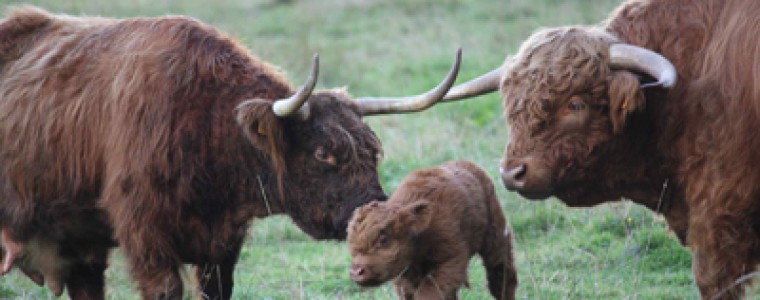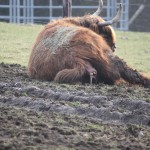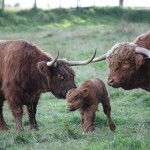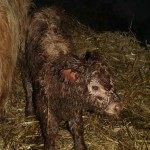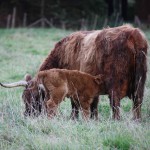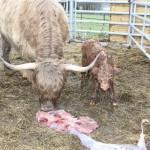Interesting facts about the birth
Birth problems are more likely to be the exception for Highland cattle, but it can happen. In general, heifers can be covered for the first time when they reach 60% of the final weight of the adult cow, ie a cow to a weight between 500 and 650 kg, can be used as heifer weighing 300 – 390 kg be occupied. Other breeders are geared to the sacrum height and show a general way with an average height of 125 – 130 cm sacrum height.
Cattle take in about 285 days.
When you enter a bull to the herd, you have to remember that birds in the summer months are more dangerous than in the cold months. Flies lay their eggs in the still wet hair from the calf. The maggots of this fly then eat the calf from the inside of her. If a birth in the summer is inevitable, it would be of great importance to accurately monitor the calf for several days. For this purpose, it would be ideal to hold mother and calf for a few days in the barn or in a separate area. If the animal is constantly wagging his tail, very restless or not to be lively, one must always think of fly strike. As the first aid the calf should be washed with alcohol. The maggots come from the skin and the alcohol dries out the fly eggs. Against larvae that are already inside the body, immediately treat it with Cydectin or the like. The washing with alcohol must be repeated for several days. Fly infestation may also fall, while warm weeks of October, still occur.
In the beef cattle breed, the calving date can also be left completely natural. Here you can find surprisingly that is also reduces the births in the summer. The result of a 10-year study of a mother-cows herd, where the bull was staying permanently in the herd, shows this very impressive:
Births
Winter period = December/January/February = 20,7% of all births, of which 66,7% in February
Spring = March/April/May = 63,6% of all births, of which 61,3% in March/April
Summer = June/July/August = 8,6%
Autumn = September/October/November = 7,1%
For the just born calf, the most important thing is that it drinks. Since it is born completely unprotected against viruses and bacteria, it desperately needs in the shortest possible time, this first milk, also called colostrum, which gives the baby the necessary protection and makes it largely resistant. If the calf did not take this first milk within two hours it is strongly advisable to assist it, later this milk does not have the same effect as intestinal flora has developed. With a little help the calf will usually quickly find the milk-giving teats. If the calf can not reach on their own or if the calf is particularly awkward, it is advisable to have a bottle of colostrum ready. This helps the calf to get out of the first danger which is not become resistant, then of course applies especially to keep an eye on the mother-calf relationship works fully.
Basic condition for a good start in life is a good mother cow with good mothering abilities. Not all of it is genetically determined, but the mother also learns much of her own mother and pass it on their calves. It must be distinguished between physical and behavioral conditions. Physically a broad pelvis and broad birth canal, among other things, single out a good mother cow. The pelvis should fall slightly, with straight or slightly curved back, the tail may be slightly elevated and thus contribute to a broader birth canal. Of great importance is the nature of the udder and udder health, it should be tight with not too large teats.
A good breeding condition is desired as for fat cows the birth risk are substantially. Moreover, fertility decreases significantly to fat cows and heifers. Calves should be small (not overweight) at birth, they are often vital in the first days of life and then grow even faster. The basis for easy calving lies both in the genetic predisposition of the cow and in the proper feeding supply while pregnancy. Head and pelvis size of the calves are important for fast delivery. In terms of easy calving, the selection of bulls, plays a big role. The selection criteria of a good breeding bull are not just size, length, weight and good daily weight gain, it must also criteria such as character, easy calving, health and good living benefits are considered in more detail in the parent lines. Animals whose sire and dam lines have frequently problems should not be used for breeding.
Mother’s characteristics :
With heifers one has in general to be careful. You never know how they react. As it is also a new experience for them, we can not anticipate the instinctive reactions. A good and experienced mother cow ie preparing for the birth. She holds back when there is conflict within the herd. Hours or days before the birth she has been looking for a suitable place where she can calve undisturbed. After birth, the mother cow will be alone with her calf, which allows her to deal intensively with her calf, thus building a good mother-child relationship. This bond is for the survival of the calf absolutely necessary. Peace and privacy are prerequisites for good and strong labor pains, which in turn are a prerequisite for rapid and smooth delivery. As soon as the calf saw the light of the world, the mother licks it carefully dry.
Most the cow annonced the birth by loud shouts to the herd. This by pushing the calf is animated to get up. Once the calf has a sure standing position, the mother will help to find by putting herself parallel to the calf. Here, she licks the calf in the anal region and animated it so the calves pitch (first bowel contents) should be discontinued. If the calf once found the udder and started to suck, this promotes the production of hormones in the cow, which leads to contraction of the uterus, causing contractions and the withdrawal of the placenta out. By the cries of the mother cow rushes in the curious flock to welcome the new member. In this case, admonished the mother toss of horns, all other members of the herd to stay away. For several days, the mother responded very defensively to protect her newborn, takes it to a safe place, from where she has a constant eye on running, just sent in the opposite direction to reveal potential enemies not the berth to the calf. After a few days if the mother has integrated the calf in the herd, flautet this defensive behavior gradually.

